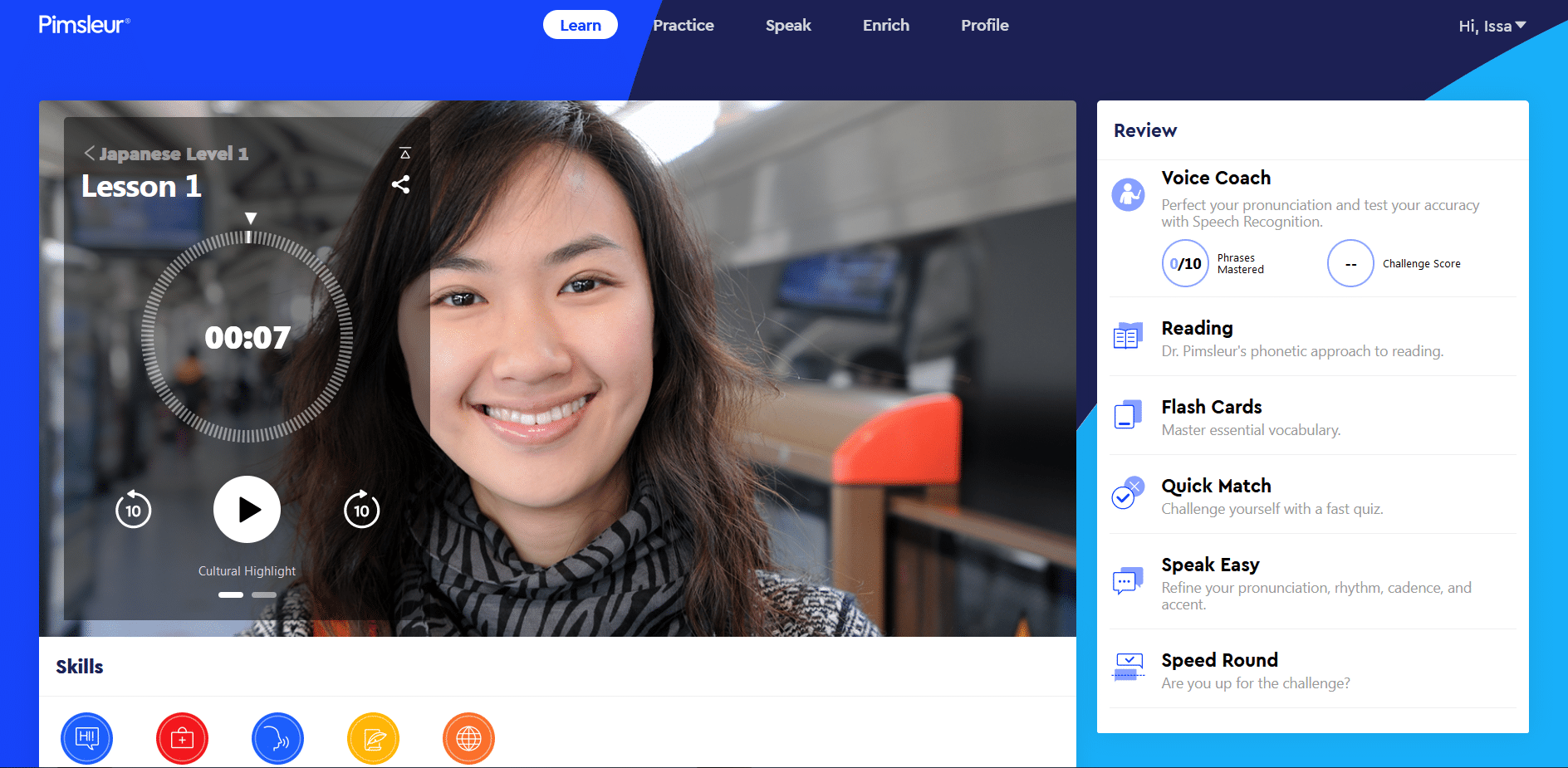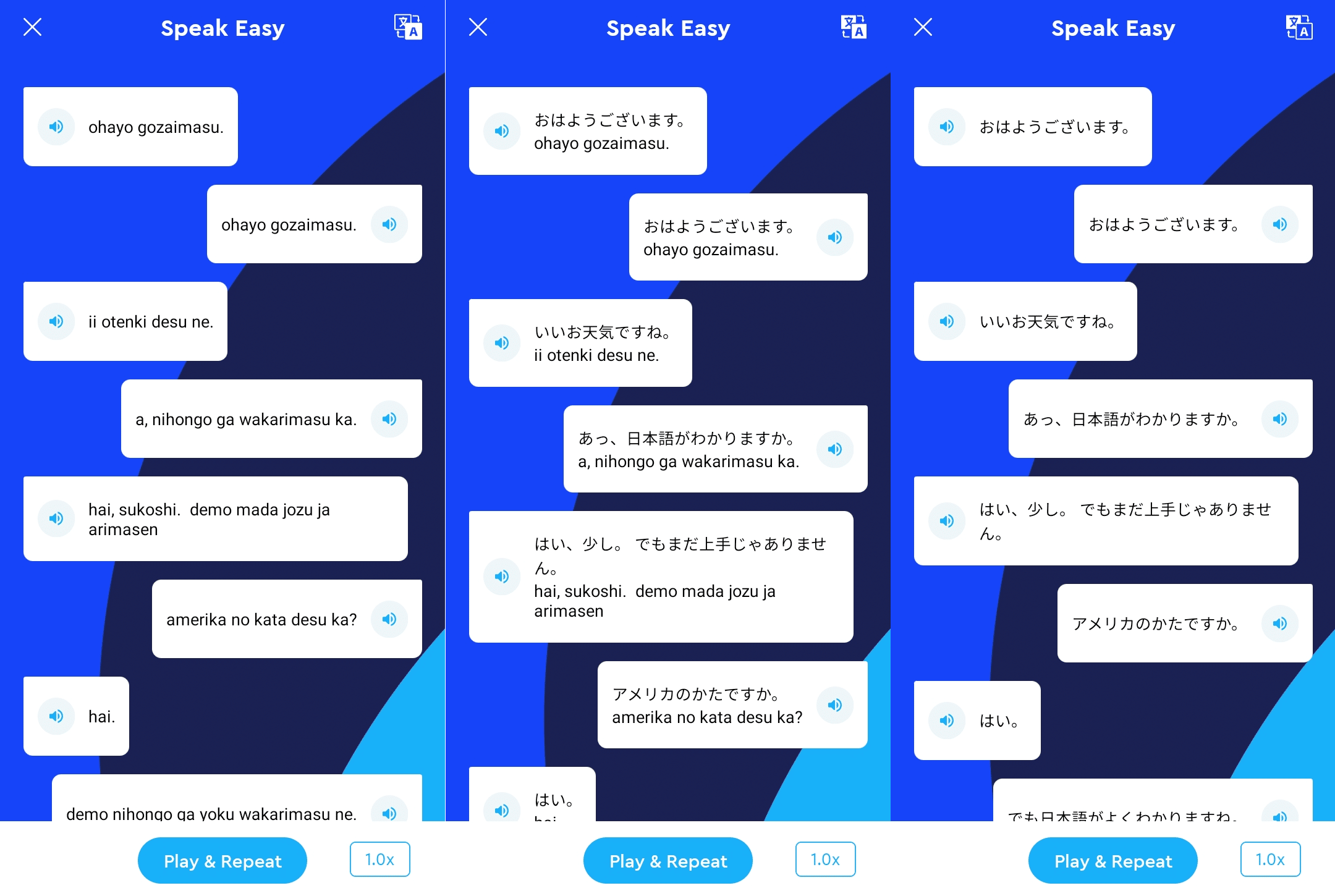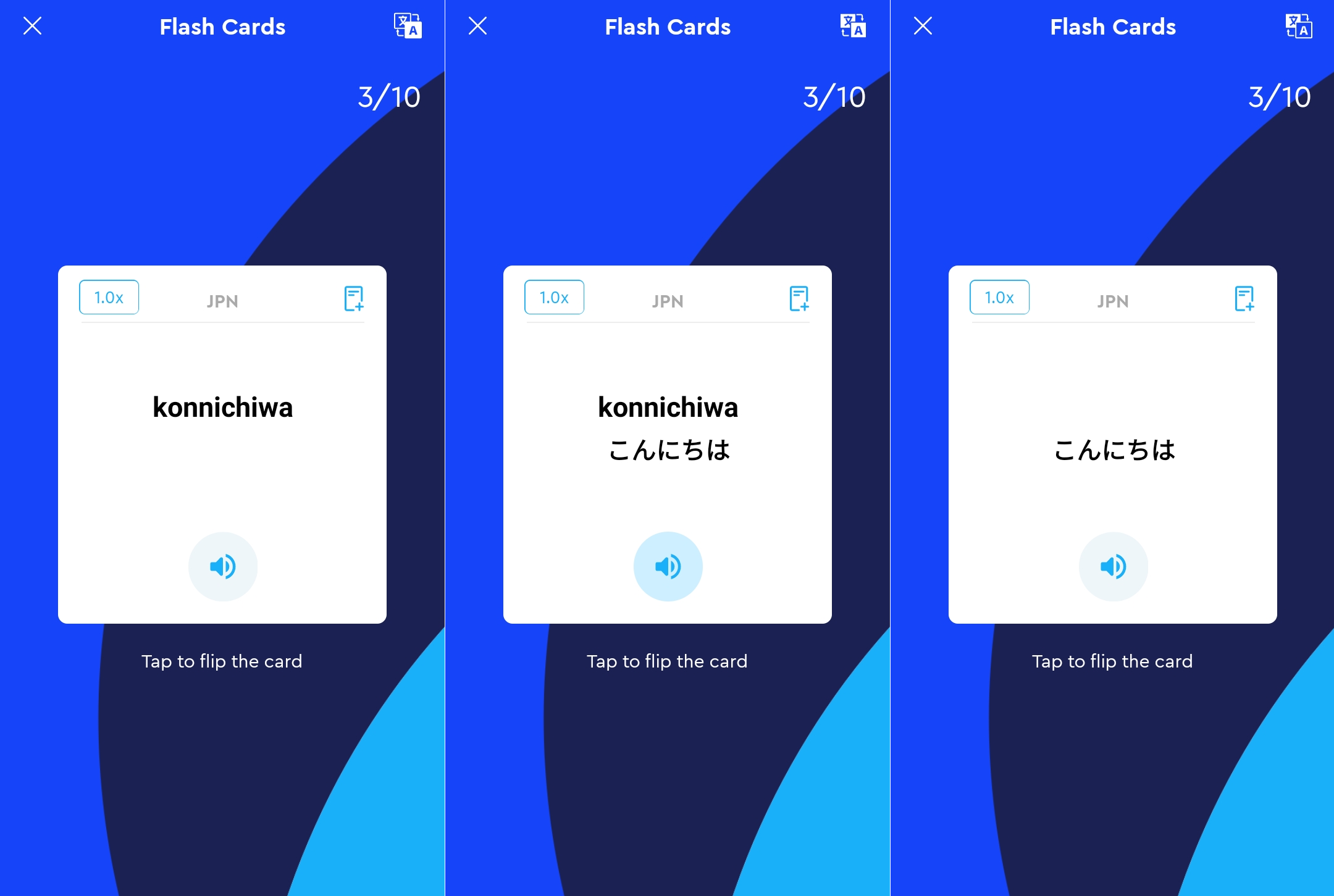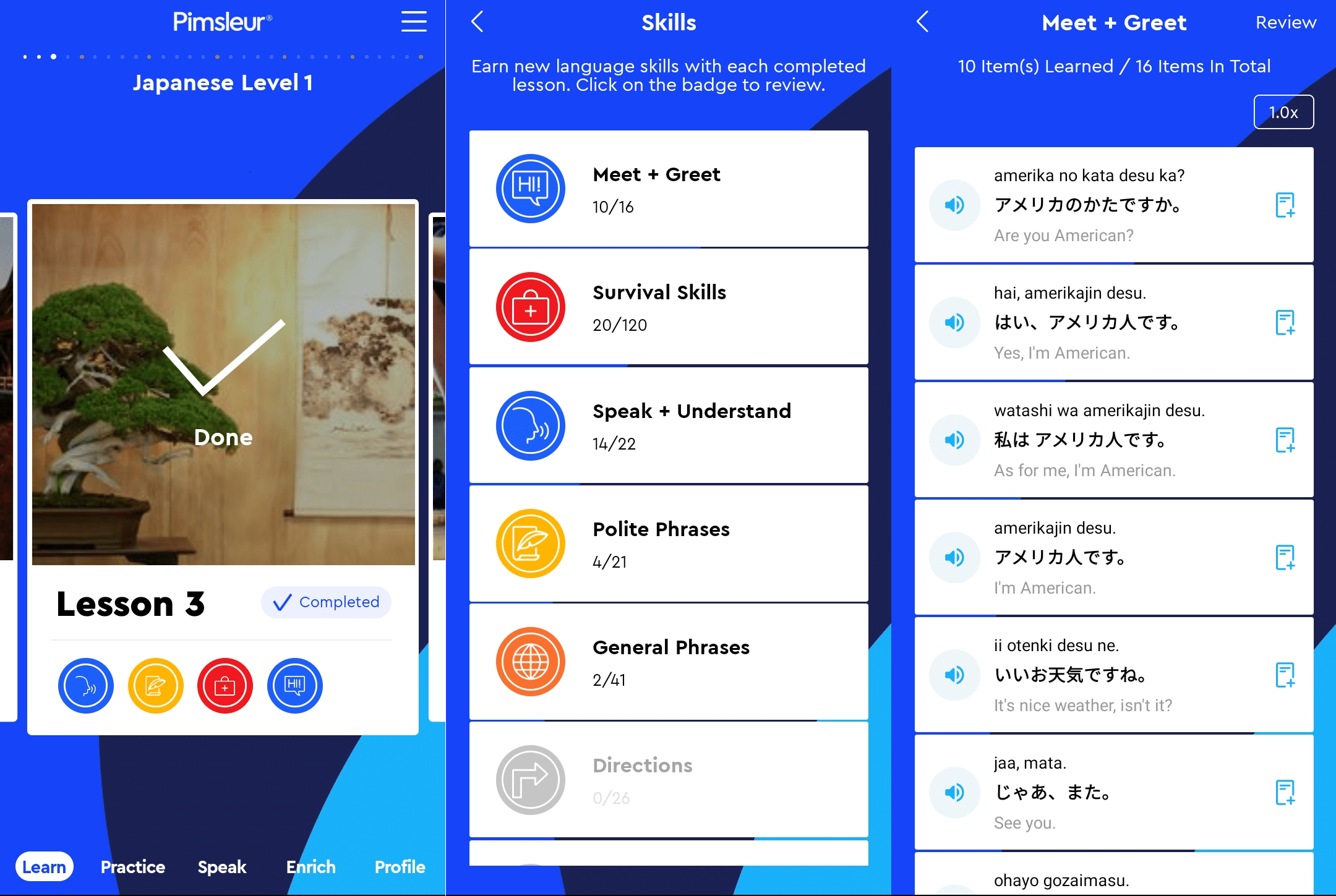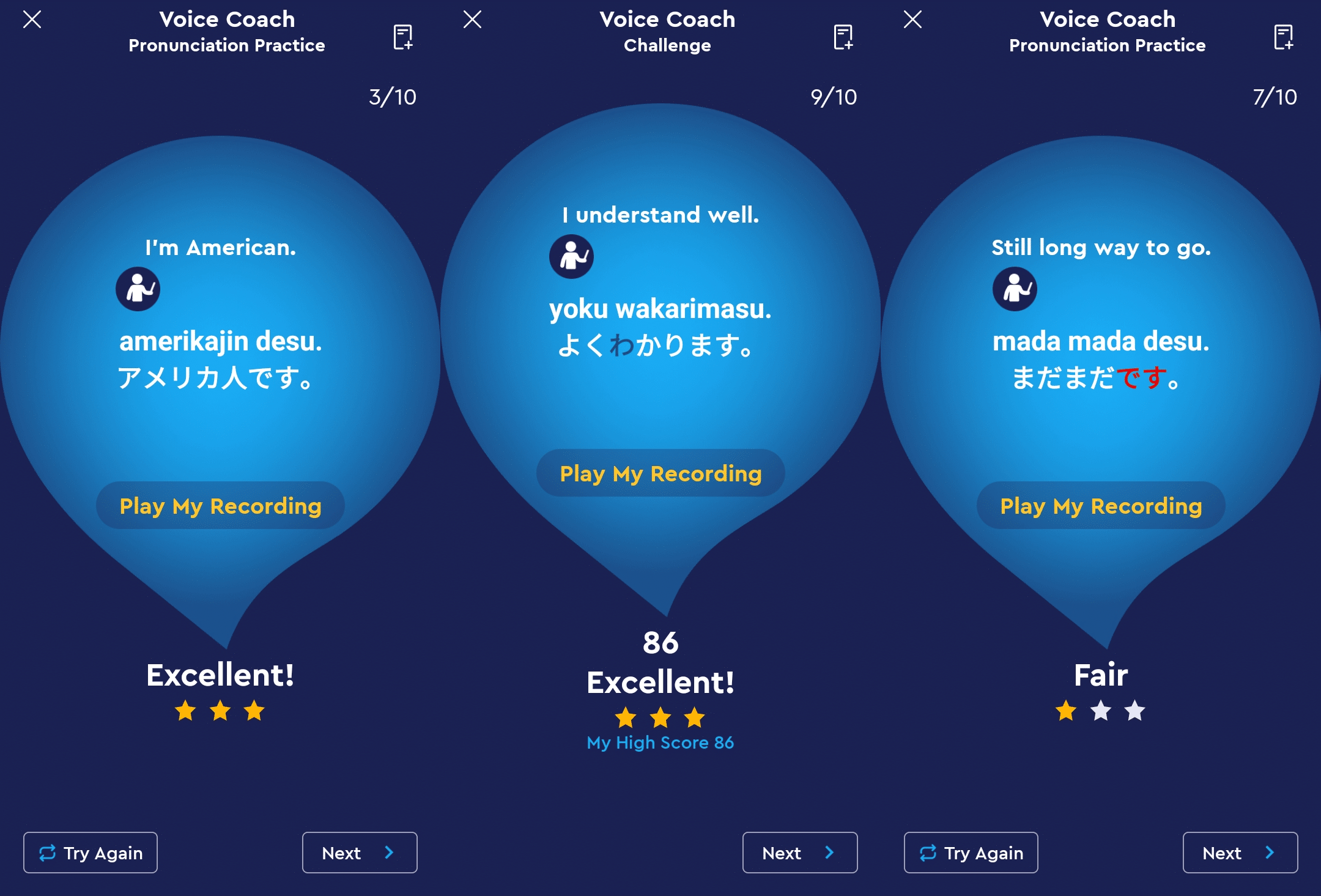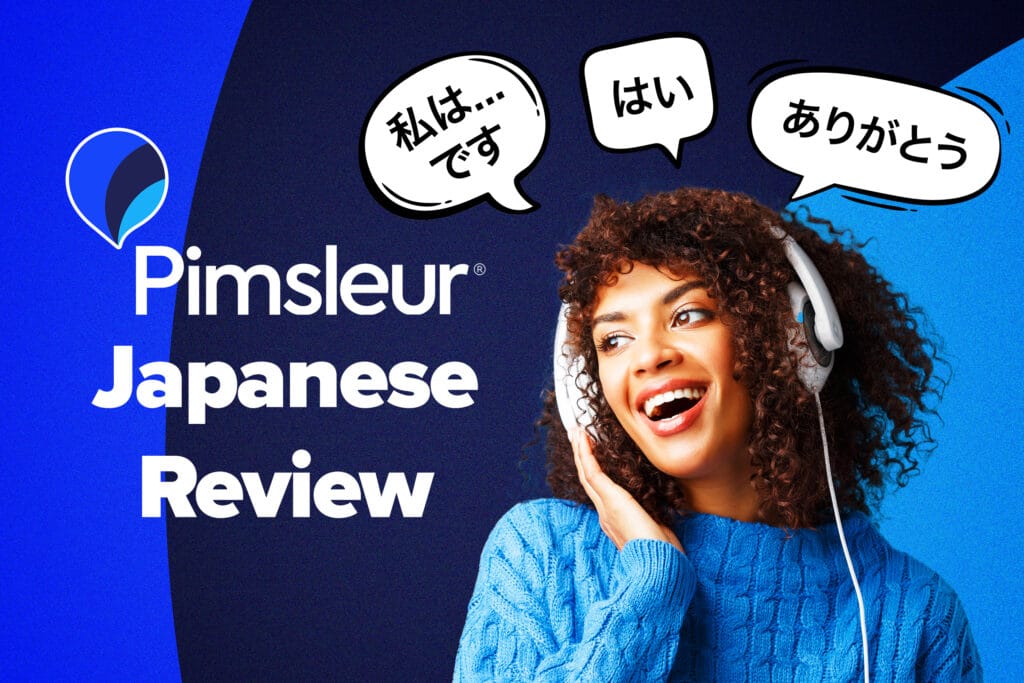
Pimsleur Japanese Review: Strong Beginner Audio Lessons with Some Half-baked Features
I picked up Pimsleur Japanese years ago when I was planning a trip to Japan.
I figured the focus on conversational skills would serve me well—and it did.
Since then, the program has added features to appeal to learners who aren’t as interested in an audio-only approach.
Now that I’m at the intermediate level and interested in brushing up on my Japanese, I decided to revisit the program. I figured the familiarity of it might help jog my memory for the language.
Overall, I think it totally holds up—it’s a solid audio program for beginner Japanese learners with clearly structured courses and progress tracking. The newer features, like Voice Coach, have added more dimension to it. My only complaint is perhaps that some of these features feel like they’re still in need of development. I’ll get into all of this in detail in my review.
If you prefer a video, you can also see my colleague’s review of Pimsleur here:
Overview

Name: Pimsleur Japanese
Description: Pimsleur's Japanese language learning program
Offer price: 7-day free trial available; starts at $150 per lesson
Summary
Pimsleur’s main lessons provide a solid background in spoken Japanese. The supplemental features, on the other hand, could use some improvements.
- User friendliness - 7/107/10
- Delivers on promises - 8/108/10
- Authenticity - 7.5/107.5/10
- Value for price - 7/107/10
Pros
- Intuitive lesson progression
- Option to change language settings to romaji, Japanese or both
- Tracks what you’ve mastered
- Has quizzes and games to reinforce what you’ve learned
Cons
- Some features feel underdeveloped
- Vital language nuances are lost in places
Contents
- How the Pimsleur System Works
- Pimsleur Japanese: Course Structure
- What I Liked About Pimsleur Japanese
- What I Didn’t Like About Pimsleur Japanese
- Who Would Benefit from Pimsleur Japanese?
- Alternatives to Pimsleur Japanese
- Final Verdict
Download: This blog post is available as a convenient and portable PDF that you can take anywhere. Click here to get a copy. (Download)
How the Pimsleur System Works
Before we get into the nuts and bolts of Pimsleur Japanese, let’s take a look at how Pimsleur works in general.
Pimsleur uses shadowing and spaced repetition techniques to teach you how to speak in your target language. Here’s how that works in practice:
- You listen to a snippet of a conversation in your target language.
- That conversation is broken down into digestible chunks of information on vocabulary, grammar, context, etc.
- You’ll be asked to listen carefully to native speaker audio of the words or phrases used in the conversation, starting from the very first one.
- You’ll then be asked to repeat the native speaker audio out loud and as closely as you can.
Of course, Pimsleur doesn’t just make you parrot phrases in your target language. It also repeats and intersperses these phrases between the others you’re learning within each lesson, ensuring that you remember what they mean and what context they should be used in.
The idea behind this system is that it emulates how you’d pick up your native language growing up. Think of how you learned words according to how immediately useful they were to you—e.g., you first learned “mama” and “papa” to address your parents, then “milk” to indicate that you’re hungry and so on. Pimsleur works in roughly the same way, except (unlike when you were a baby or toddler) you’re much more aware of the process happening.
Pimsleur Japanese: Course Structure
The entire Pimsleur Japanese course consists of five levels divided into 30 lessons each. Each lesson has a 30-minute audio file as its main component, with additional features intended to supplement what you’ve learned.
After the very first lesson, each succeeding lesson starts with a quick refresher of the previous one and gradually builds on that.
What level it’s aimed at
The course seems to be aimed at beginner to intermediate learners. Going through the lessons, I’d say that if you’re preparing for the Japanese Language Proficiency Test (JLPT), it’ll help you up to N4, at most.
What topics it covers
Pimsleur Japanese focuses on conversation practice. As such, topics like directions, food, travel and activities will be front and center all throughout.
How long it takes to finish the whole course
Assuming you’re only using the 30-minute audio lessons, you’d spend a total of 4,500 minutes (30 minutes x 30 lessons x 5 levels) or 75 hours on Pimsleur Japanese. Even if you decide to spend just an hour per day on the program, you could actually finish it in less than three months.
What I Liked About Pimsleur Japanese
Intuitive progression of core lessons
The very first phrase you’ll learn is すみません、英語がわかりますか? (すみません、えいごがわかりますか?) — “Excuse me, can you understand English?” It’s a pretty useful expression if you’re traveling to or staying in Japan, considering that less than two percent of English speakers in Japan are highly fluent in the language.
Lesson 1 continues to build on that first phrase, letting you practice expressions like 日本語が少しわかります (にほんごがすこしわかります) — “I understand a little Japanese” and 日本語がわかりません (にほんごがわかりません) — “I don’t understand Japanese.”
The next lessons move on to greetings like おはよう — the casual version of “Good morning,” questions about directions like 上野駅はどこですか? (うえのえきはどこですか?) — “Where is Ueno station?” and other essential phrases for navigating daily life in Japan as a foreigner.
Of course, as the lessons progress, the difficulty level increases, as well. But it’s clear that a lot of thought was put into the sequence of how the phrases will be taught. With Pimsleur, the acquisition process feels pretty natural—similar to what you might experience if you were learning while abroad in Japan.
Flexible language preferences
If you’re using the non-audio components of Pimsleur Japanese, you have three language options: romaji, romaji with Japanese or Japanese only. Just hit the translation icon at the upper-right corner of your screen to toggle between these options.
In case you haven’t started learning the three Japanese writing systems (hiragana, katakana and kanji) yet, romaji is a decent starting point. It’s made of Japanese words written in the Roman alphabet, making it useful for when you just need the basics to get around the country.
But if you’re dead set on becoming fluent in the language, and you already have a decent handle on its written form, I suggest using the Japanese settings whenever you can. As I’ve mentioned earlier, English isn’t widely spoken or used in Japan, even if establishments in urban areas are becoming increasingly bilingual. In my opinion, the sooner you learn how to read Japanese using the native writing system, the better.
Ability to track what you’ve learned
The problem with the old audio-only system of Pimsleur is that, unless you take meticulous notes as you listen, there’s no way to lay out those new phrases in front of you and be like, “Oh yeah, this is what I’ve learned today.”
Luckily, with the current iteration of Pimsleur, you can now view your new phrases via “Flash Cards” and “Speak Easy.” The former is, true to its name, a straightforward set of all your new vocabulary in flashcard form. The latter is basically a transcript of the main conversation you studied throughout the lesson.
Both “Flash Cards” and “Speak Easy” come with audio, so you can review how the words sound as well as how they look. You can also choose how the words should be written—in romaji, pure Japanese or both.
Right underneath each 30-minute audio lesson, you can find your new vocabulary under categories such as “Meet + Greet,” “Survival Skills,” “General Phrases” and so on. You can also see “x/y” numerical indicators within each category, where x is how much you’ve mastered and y is how much you should master, giving you a bird’s eye view of how far along you are in the course.
Option to test what you’ve learned
Another issue with the old Pimsleur system is that there’s no way to quickly gauge how much you’ve retained from each lesson. To do that, you needed to proceed to the next lesson and refresh what you’ve learned within the first few minutes of the audio, which can be a hassle if you’re pressed for time. The program addresses that with “Quick Match” and “Speed Round.”
“Quick Match” consists of a short multiple-choice quiz, which I thought was okay. My only (minor) gripe is that its blurb says “Challenge yourself with a fast quiz,” but I didn’t really feel the “fast” part at all. Maybe “fast” refers to the estimated time it would take to complete the quiz, since it’s so short?
“Speed Round,” on the other hand, lives up to its name. The game consists of English phrases falling down from above a la Tetris blocks, and you have to match them to their corresponding Japanese translations before they touch the ground. If you enjoy challenging games where you learn new stuff at the same time, I think you’ll love this one (I certainly did). And if the romaji translations are too easy, you could always change the settings to the written Japanese version to bump up the difficulty a bit.
What I Didn’t Like About Pimsleur Japanese
Some half-baked features
Pimsleur is, and has always been, designed for self-study. The downside of most self-study audio programs is that there’s no way to get feedback on your pronunciation, accent, etc.
That sort of feedback is especially important for native English speakers, because Japanese pronunciation has some quirks that can take a bit of time to get used to—e.g., pronouncing the “r” sound in a very specific way. (Some say it’s like the Spanish “r” sound, but I think that’s only half-true. As you can hear from this video, the Japanese “r” also subtly incorporates “l” and “d” sounds.)
Pimsleur attempts to address this with “Voice Coach,” which is subdivided into “Pronunciation Practice” and “Challenge.” “Pronunciation Practice” is a self-paced guided audio course on the phrases discussed in the current lesson, while “Challenge” is essentially an audio quiz based on what you’ve learned from “Pronunciation Practice.”
In theory, this should’ve been a good idea: Listen to a phrase, record it in the app and receive a score on how well you pronounced (or, I suppose, imitated) that phrase. It should also be a great supplement for learners who need a “Cliff’s Notes” version of the main lesson.
While both sections in “Voice Coach” highlight what you’ve mispronounced with color indicators, they don’t really specify what kind of mistake you made or how you could improve on it. Sure, you could try to zero in on the problem by repeatedly listening to your recording vis-à-vis the native speaker audio, but then you could always do that via other means. Also, how do you know the issue isn’t a slight (and possibly inaudible) difference in pronunciation or perhaps a technical problem?
Another thing I took issue with is the “Mini” section, which you can access by tapping “Enrich” on the main screen.
“Mini,” as the name implies, consists of shorter audio files. The first few minutes are the narrator dishing out tidbits about the topic, while the rest is a very compressed, “speed run” version of the main Pimsleur lessons. I felt that the “Minis” tried to pack too much information into too little space, and are more appropriate for intermediate learners looking for a refresher. Granted, the narrator advises that you should probably re-listen to the audio anyway—but then, shouldn’t Pimsleur be doing the repetition bit for you in the first place?
Also, while I can understand the logic behind separating certain topics (e.g., “Improve Your Japanese With Anime”) from the main lessons, I feel like these should’ve been longer bonus lessons instead. I, for one, am curious about what other anime expressions learners (mistakenly) incorporate into everyday language other than Naruto’s iconic だってばよ (dattebayo).
Finally, even though there’s a “Reading” component, you can’t access it until Lesson 11. I understand that reading practice isn’t Pimsleur’s main thrust, but I feel that the program made an odd choice when it comes to the order in which learners can access this feature. As I’ve mentioned earlier, I believe it’s important that learners be exposed to the native Japanese writing system as soon as possible, so this is probably the weakest part of the program for me.
Nuance is lost in places
As someone who used to be a complete beginner to Japanese, I can understand why Pimsleur simplifies lessons to the extent it does. The last thing you want as a beginner is to get overloaded with information from the get-go, especially when dealing with a Category IV language like Japanese. (A Category IV language is one which is, in the words of the U.S. State Department’s Foreign Service Institute, “exceptionally difficult for native English speakers [to master].”)
However, I also think it’s important for Japanese learners to have a solid foundation, even if that means being a bit uncomfortable with the learning methods presented to them at first. As someone who’s somewhere between the beginner and intermediate level of Japanese, I couldn’t help but notice that Pimsleur cut a few corners to make the lessons easier to digest.
For example, in Lesson 1, 英語が (えいごが) — English ga is simply explained as “English as used in a sentence.” Instead of the somewhat vague “used in a sentence,” the program could’ve said “English as the subject of the sentence.” That way, learners already have a good grasp of how the Japanese particle ga functions from the beginning.
I also noticed that the program failed to highlight that こんにちは (good afternoon) should be pronounced as kon-ni-chi-wa (with the first syllable ending in an n sound) rather than ko-ni-chi-wa. The difference is subtle, but it’s still an important one considering that it’s a common Japanese expression—and that Pimsleur is supposed to help you improve your pronunciation.
And those are just a couple of examples I’ve noticed while using the program. To be clear, I’m not saying the information on Pimsleur is necessarily inaccurate. I’m saying that the important nuances, whenever they’re present, should be highlighted and not sacrificed for the sake of easy learning.
Who Would Benefit from Pimsleur Japanese?
The way the program is designed now, I think the people who’d get the most from Pimsleur Japanese are:
- Those who intend to travel to and stay in Japan for only a temporary period. This is really the main target audience of the program, in my opinion. For one, the foundational lessons consist of travel-related/survival phrases (as opposed to, say, Japan’s writing systems). There’s also the fact that each audio lesson has a random cultural tidbit about Japan that you can access by swiping the main audio lesson screen.
- Complete beginners to the language. My previous gripes about the lack of nuance aside, I still think this is a solid introductory program for those who want to start learning spoken Japanese.
- Intermediate students who need a refresher. I think intermediate Japanese learners would agree with me when I say that going back to the basics is a good idea now and then. For example, I knew that 方 (かた) refers to how something is done, but I didn’t know it was also a polite way to refer to a person!
Alternatives to Pimsleur Japanese
But what if you’re not in any of the groups I just mentioned above? Maybe consider these alternatives instead:
JapanesePod101

For one, it extends up to advanced levels of Japanese. Along the way, starting in the beginner stages, you can tell they’re trying to wean you off of English entirely. This is neat if you’re looking for more challenging and immersive material.
Also, JapanesePod101 definitely has more to offer in terms of reading practice. Check out our full review of JapanesePod101.
FluentU
FluentU features authentic videos in your target language that native speakers actually watch. That means that, unlike a mostly audio-based program like Pimsleur, you get exposed to the language as it’s used in real life (as opposed to the stilted, boilerplate phrases language learning programs often use).
You can also see how native Japanese speakers incorporate body language to express or emphasize what they’re saying, which is a nice bonus!
Final Verdict
If I could compare this current iteration of Pimsleur to the one I used years ago, I’d say that it’s an improvement overall.
For one, I appreciate the add-ons like flashcards and quizzes that allow me to reinforce what I’ve learned.
On the other hand, I think features like “Voice Coach” and “Minis” could use some tweaking, especially since they’re basically supplemental audio lessons—which is Pimsleur’s main product.
For those traveling to Japan, as well as beginner to lower-intermediate learners, this is a good supplement to the other Japanese learning materials you may be using.
